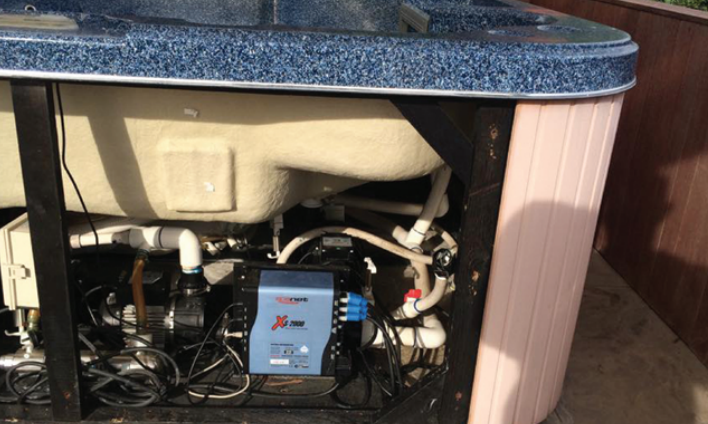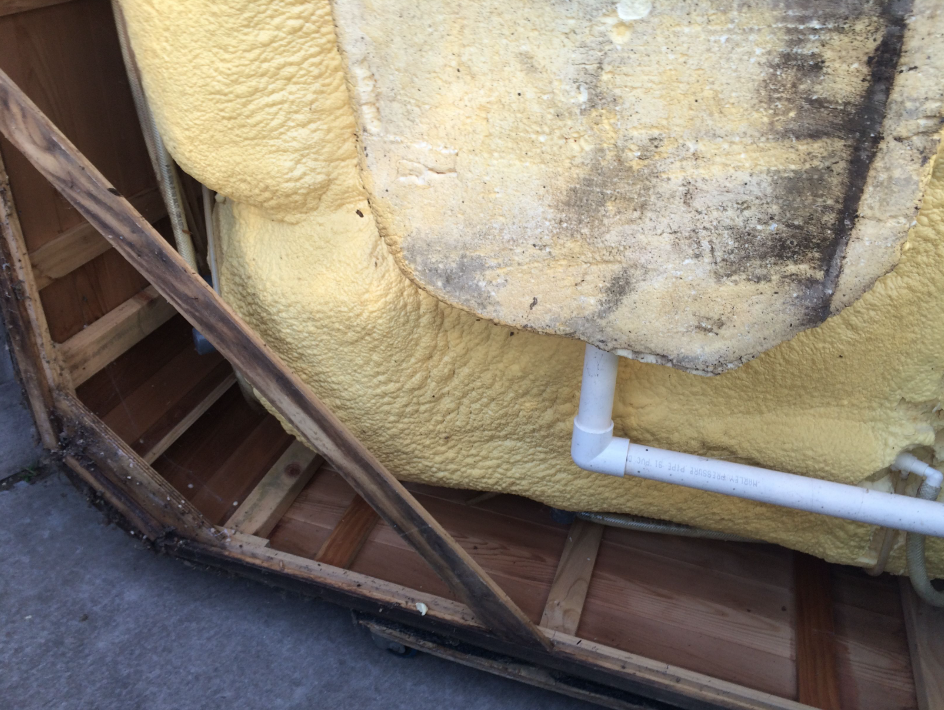Insulation
All spa insulation is not created equal. Typically, every spa is going to be insulated in two ways, the top (cover), and the sides (area between the shell and exterior of the spa. Covers can range from 1.0 lb. and 2.0 in foam density. The higher the number, the better hot tub insulation it will offer. Most manufacturers use 2.0 lb core density, however, some less expensive spas will cut costs by lowering the foam density, as well as quality of vinyl and stitching. For a premium price, hard shell covers are a custom option and offer the best insulation, as well as longer life.
Spa insulation, which is used on the side of the spa, does vary, and often gets confusing. Below is a chart to help you understand that various insulations that are used, as well as a grade as to their effectiveness.
Type: No Insulation
Grade: F
Believe it or not, but there are spas that are manufactured without any insulation between the shell and exterior. They are rare, but they do exist. These spas are typically made inexpensively in China, and can often be found for sale on the internet and warehouse only sales. Don’t be fooled by words that say “insulated spa” but never mention what type of insulation is used. They may just be referring the the cover that it comes with. Spas with no insulation will result in higher energy cost, as well as potential problems with shell cracks as there is no support.

Type: Thermal Wrap or Blanket
Grade: D
This spa insulation practice consists of an insulation blanket being wrapped along the lining of the shell and/or inside exterior walls. There is a large void of space that is exposed. This spa pool insulation method is often compared to that of what is standard for insulating refrigerators. What it fails to mention is that it is not used for insulation of industrial freezers. Instead full foam insulation is used for this application. It is not as energy efficient as other methods, and does not provide strength support for the shell, or the spa siding.

Type: Partial Urethane Foam Insulation
Grade: D
This spa pool insulation method is fairly common. A layer of foam insulation is sprayed on the inner lining of the shell. It provides about the same level of insulation as the thermal wrap, with one advantage. The foam will add strength to the shell. Often consumers misunderstand the specifications and mistake partial foams as being full foam. You will know it is a partial foam application if the word “full” is not used in the specs.

Type: Full Urethane Foam Insulation 2lb (HotSpring spas 1991-2011)
Grade: C
This spa pool insulation is also commonly found in spas. This is a good insulation system. Not only does it provide good hot tub insulation, but the support that it provides for both the shell and the plumbing will result in fewer leaks and a greater chance that the shell does not weaken and crack over time. Do not be worried by claims that plumbing repairs are more difficult and costly due to trying to work around the foam. Instead find comfort in the knowledge that your spa will experience far fewer plumbing leaks due to the added support that the lines have. The vibration of lines is most often what causes a leak, and spas with full foam experience 10 times fewer leaks that those without foam.

Type: FiberCor Insulation
Grade: B (HOT SPRING SPAS)
Relatively new to the market, FiberCor is a great answer for consumers who have concerns with full foam and the potential of costly leak repairs. FiberCor has four times the density of the urethane foam used in most hot tubs. It’s a loose, wool-like fiber that fills all voids and gaps in our hot tub compartments for better insulating efficiency than any other hot tub. It is also very easy to remove, making future repairs easier then full foam.

Type: Multi Density and Multi Layered Full Urethane Foam
Grade: A (HOT SPRING SPAS)
This is the best hot tub insulation you will find when it comes keeping the heat in and providing your spa shell and the equipment with the absolute best support against plumbing leaks and cracks in the shell. This system begins with a 60lb foam being shot onto the shell lining, making the shell stronger then others. It is then followed by multiple layers of foam of a variety of densities providing over all density that is greater then 2lb. Many consumers ask, why don’t other spas just use a 4lb or 6lb full foam to achieve better insulation, and it is is because of the foams expansion. The expansion of using a 2lb foam to fill the spa will not cause damage to the shell or exterior. However, if a spa is filled entirely with, lets say 4lb foam, it will expand and likely cause damage over time to the spa. Using a variety of density foam in multiple layers allows the foam to expand into each other, creating an all higher rating of density. Due to the increased cost of assembly time and assembly space needed to achieve this system, is not commonly used when manufacturing spas.




